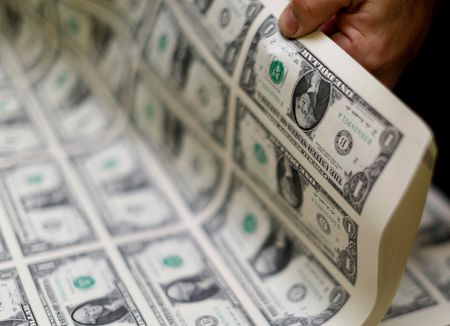By Karen Brettell
NEW YORK (Reuters) – The dollar dipped on Friday as a Federal Reserve official said rate hikes are likely to slow and as investors took profits from earlier gains after jobs data and wage inflation were surprisingly strong in November and muddied the outlook for how hawkish the U.S. central bank will be.
The greenback initially jumped after data showed that employers added 263,000 jobs in November, well above estimates of 200,000.
“Stronger-than-expected hiring can buy the Fed more time to stay aggressive,” Joe Manimbo, senior market analyst at Convera in Washington, said.
Investors zeroed in on an increase in average hourly earnings by 0.6% in the month, above expectations for a 0.3% gain, and the participation rate, which declined to 62.1%, Marc Chandler, chief market strategist at Bannockburn Global Forex in New York, said.
“Both of those measures reflect more than the nonfarm payroll growth number the tightness of the labor market,” he added.
But the dollar gave back gains as investors took profits before the weekend and as Fed officials spoke on the outlook.
Chicago Fed President Charles Evans said that the pace of increases is likely to slow, but added that the U.S. central bank will likely need to raise borrowing costs to a “slightly higher” peak than envisioned in forecasts from September.
Richmond Fed President Thomas Barkin also said the United States is likely in a sustained period in which there will remain a shortage of workers, complicating the Fed’s aim of getting labor demand back into balance.
The dollar index was last down 0.13% on the day against a basket of currencies at 104.50, and the euro gained 0.10% to $1.0537, the highest since June 28.
The greenback slipped 0.71% on the day against the Japanese yen to 134.38. It earlier reached 133.62 yen, the weakest since August 16.
The greenback had tumbled after Fed Chairman Jerome Powell said on Wednesday that it was time to slow rate hikes, raising hopes that the Fed was closer to the end of its tightening cycle.
Data on Thursday also showed that inflation is moderating, with the personal consumption expenditures (PCE) price index rising 0.3% after advancing by the same margin in September. In the 12 months through October, the PCE price index increased 6.0% after advancing 6.3% in September.
“Markets are really buying into the pivot story from the Fed,” ING FX strategist Francesco Pesole said.
The next major U.S. economic indicator will be consumer price inflation data due on Dec. 13, one day before the Fed concludes its two-day meeting.
The U.S. central bank is expected to increase rates by an additional 50 basis points at the meeting. Fed funds futures traders are now pricing for the Fed’s benchmark rate to peak at 4.92% in May.
========================================================
Currency bid prices at 3:11PM (2011 GMT)
Description RIC Last U.S. Close Pct Change YTD Pct High Bid Low Bid
Previous Change
Session
Dollar index 104.5000 104.6600 -0.13% 9.238% +105.5900 +104.3600
Euro/Dollar $1.0537 $1.0526 +0.10% -7.32% +$1.0545 +$1.0430
Dollar/Yen 134.3800 135.3300 -0.71% +16.72% +135.9750 +133.6200
Euro/Yen 141.58 142.42 -0.59% +8.66% +142.4700 +140.7800
Dollar/Swiss 0.9374 0.9370 +0.04% +2.76% +0.9439 +0.9326
Sterling/Dollar $1.2295 $1.2264 +0.27% -9.08% +$1.2300 +$1.2137
Dollar/Canadian 1.3458 1.3433 +0.18% +6.43% +1.3520 +1.3422
Aussie/Dollar $0.6811 $0.6812 +0.00% -6.29% +$0.6836 +$0.6743
Euro/Swiss 0.9877 0.9857 +0.20% -4.74% +0.9878 +0.9824
Euro/Sterling 0.8567 0.8589 -0.26% +1.99% +0.8608 +0.8556
NZ $0.6410 $0.6372 +0.61% -6.33% +$0.6413 +$0.6330
Dollar/Dollar
Dollar/Norway 9.7735 9.7265 +0.67% +11.15% +9.8630 +9.7420
Euro/Norway 10.2989 10.2368 +0.61% +2.86% +10.3206 +10.2293
Dollar/Sweden 10.3208 10.2912 +0.33% +14.46% +10.4659 +10.2891
Euro/Sweden 10.8752 10.8390 +0.33% +6.27% +10.9202 +10.8382
(Additional reporting by Samuel Indyk in London and Gertrude Chavez-Dreyfuss in New York; Editing by Susan Fenton and Andrew Heavens)

